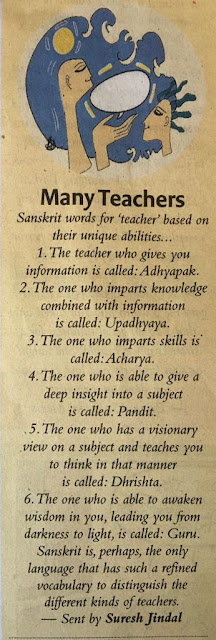Inputs on Research in Manuscriptology
My notes on Prof.Aklujkar's lecture at Sri Chandrasekarendra Sarasvati Vishvamahavidyala Enathu Kanchipuram oct 5, 2017.
1. Historical method of Research has it's own advantage. Shivaji Maharaj inquired about the background of Surat (British) merchants. Based on that built Maratha Navy. Whereas Nana Phadnavis, very intelligent Martha Peshva, did not care about the aggressors history or background and hence lost to the British.
2. Soft power is important. China is known for its Acupuncture and Vastu and hence it is projected as an advanced culture. Gets more business projects. Whereas Sanskritists do not recognize the importance of soft power. We had an open intellectual society in the past. Knowledge of the past gives a distinct advantage in the present. The old pandit is lost. We have not created a new Pandit.
3. The ratio of psychiatrist in America with its population is more when compared to the Japan. Probably due to the buddist culture that prevails in that country. How Philosophy of the past unburdens the current life.
4. Regarding Manuscript studies, one has to consult - German Scholar Karl Ludwigh Janert list of Catalogues.
5. Dominik Wujastyk maintains a website where all out of copyright Manuscript catalogues are digitally preserved and presented.
6. How Manuscript studies help redifine current understanding? Yogavasishtha is known as a Advaita vedantic work. But a 9th century work called Mokshopaya has been discovered where we find an earlier version of Yogavasishtha. It has been intelligently given a Vedantic turn by some later scholar.
7. People in Manuscript studies should also focus on Tibetan Translation of Sanskrit Manuscripts. In them we find older Sanskrit texts preserved in Tibetan. China took those Tibetan Manuscripts to Beijing digitized them and returned it back to where it belonged to. The west wanted to lay hands on the works for long for which access was not very easy. Wonderful ideas on interactions between the Brahmannical and the Buddist thoughts are recorded there in which happened during 3rd or 4th century CE. These are important old references. In Vienna a set of scholars are studying the Tibetan texts very closely and they try to arrive at the Sanskrit original. A very sincere attempt.
8. Doxography (compaision of various) philosophical thought is always related to Sarvadarshana Sangraha of the 14th Century. There texts like Bhavavivkea or Bhavya (of Buddhist origin) that are available from 4th century CE. More than thousand years ago doxography existed in Sanskrit textual tradition.
9.The aggressor always tries to wipe out intellectual traidtion of the subjucated culture. We should be aware of this.
10. People are not created equal but should be treated as equal. Brahmannical tradition of the past very superior in intellect. Brahmannical tradition has stopped study of neighboring cultures. It has stopped studying the sociology.
11. Even a Sandhi-ccheda in a Manuscript is important. Vishalamalavati of jindendrabuddhi has been split in manunuscript - Vishala Amalavati. why Sandhiccheda Because Amalavati is a preexisting text and the Vishala means an enlarged version of the Amalavati.
12. Pandits are the ones who created this India.
13. Natyashastra, Ashtadhyayi and Varttika of Ashtadhyayi have not been critically edited. These are culturally defining texts. We are just happy with the critical editions of Ramayana and Mahabharata.
Still, regional critical editions of Ramayana and Mahabharata is pending. Critical editions is important because, they help in understanding as to how the text travelled from the past to its current form.
14.In textual criticism readings are decided just based on Majority Manuscript readings. Regional peculiarities are not taken into account even if they are in minority. this is a major point to be noted in this regard.


Comments
Post a Comment